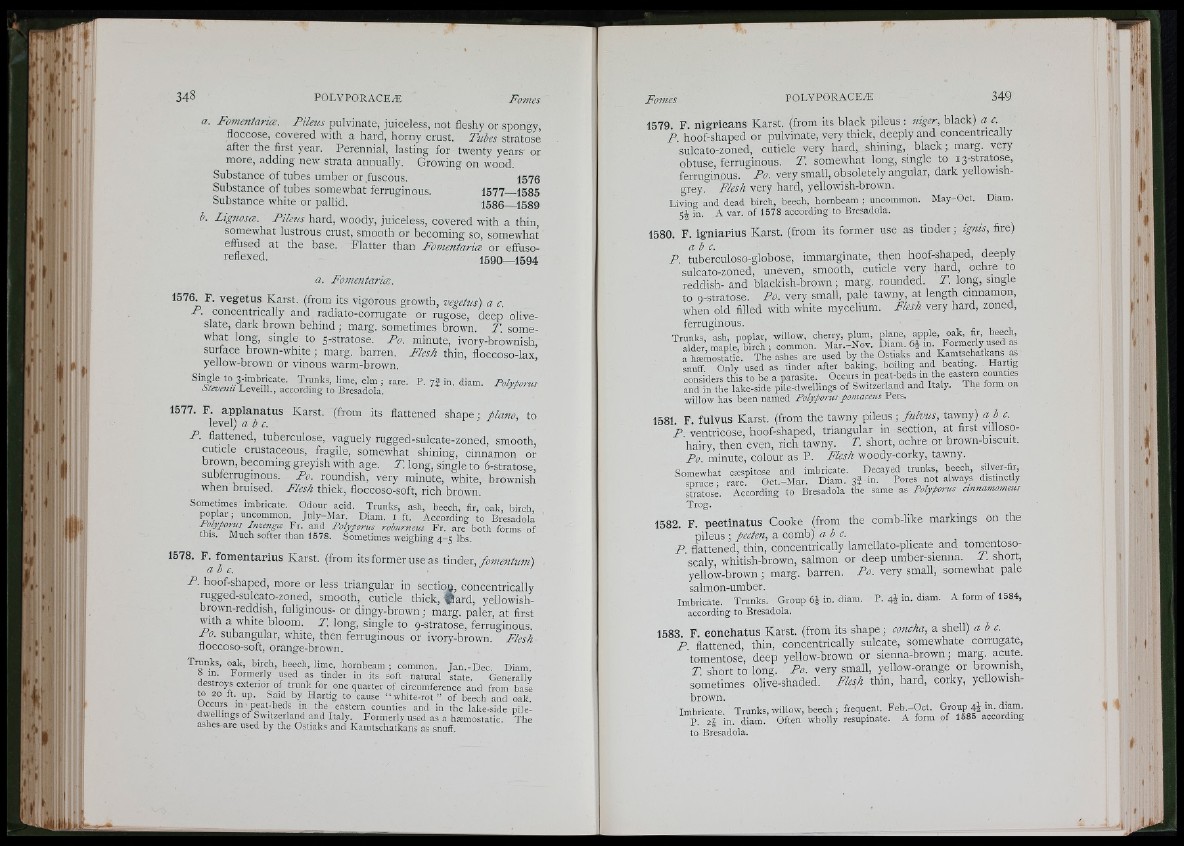
a. Fomcntarm. Pileus pulvinate, juiceless, not fleshy or spongy,
floccose, covered with a hard, horny crust. Tubes stratose
after the first year. Perennial, lasting for twenty years or
more, adding new strata annually. Growing on wood.
Substance of tubes umber or fuscous, 1576
Substance of tubes somewhat ferruginous. 1577__1585
Substance white or pallid. 1586__1589
b. Lrgnosa. Pilens hard, woody, juiceless, covered with a thin,
somewhat lustrous crust, smooth or becoming so, somewhat
effused at the base. Flatter than Fomentaria or effuso-
reflexed. 1590—1594
a. Fomeiitaria:.
1576. F. vegetus Karst, (from its vigorous growth, vegetus) a c.
P. concentrically and radiato-corrugate or rugose, deep olive-
slate, dark brown behind ; marg. sometimes brown. T. somewhat
long, single to s-stratose. Po. minute, ivory-brownish,
surface brown-white; marg, barren. Flesh thin, floccoso-lax,
yellow-brown or vinous warm-brown.
Single to 3-imbncate. Trunks, lime, elm ; rare. P. yf in. diam. Polyporus
Steve?m LeveilL, according to Bresadola.
1577. F. applanatus Karst, (from its flattened shape; piano, to
level) abc.
P. flattened, tuberculose, vaguely rugged-sulcate-zoned, smooth,
cuticle crustaceous, fragile, somewhat shining, cinnamon or
brown, becoming greyish with age. T. long, single to 6-stratose,
subferruginous. Po. roundish, very minute, white, brownish
when bruised. Flesh thick, floccoso-soft, rich brown.
Sometimes imbricate. Odour acid. Trunks, ash, beech, fir, oak, birch
poplar; uncommon. July-Mar. Diam. i ft. According to Bresadola
Polyporus Inzengco Fr. and Polyporus roburneus Fr. are botli forms of
this. Much softer than 1578. Sometimes weighing 4-5 lbs.
1578. F. fomentarius Karst, (from its former use as tinder, 10111611111111)
abc. . o !
P . hoof-shaped, more or less triangular in section, concentrically
rugged-sulcato-zoned, smooth, cuticle thick, flard, yellowish-
brown-reddish, fuliginous- or dingy-brown; marg. paler, at first
with a white bloom. T. long, single to 9-stratose, ferruginous.
Po. subangular, white, then ferruginous or ivory-brown. Flesh
floccoso-soft, orange-brown.
Trunks, oak, birch, beech, lime, hornbeam ; common. Jan.-Dec. Diam.
» m. Formerly used as tinder in its soft natural state. Generally
destroys exterior of trunk for one quarter of circumference and from base
to 20 ft. up. Said by Hartig to cause “ white-rot” of beech and oak
Occurs in peat-beds in the eastern counties and in the lake-side pile-
dwellings of Switzerland and Italy. Formerly used as a hmmosiatic. The
ashes are used by the Ostiaks and Kamtschatkans as snuff
1579 F. nigricans Karst, (from its black pileus : niger, black) a c.
P. hoof-shaped or pulvinate, very thick, deeply and concentrically
sulcato-zoned, cuticle very hard, shining, black ; marg. very
obtuse, ferruginous. T. somewhat long, single to 13-stratose,
ferruginous. Po. very small, obsoletely angular, dark yellowish-
grey.'” Flesh very hard, yellowish-brown.
Living and dead birch, beech, hornbeam ; uncommon. May-Oct. Diam.
5® in. A var. of 1578 according to Bresadola.
1580. F. igniarius Karst, (from its former use as tinder ; ignis, fire)
P tuberculoso-globose, immarginate, then hoof-shaped, deeply
sulcato-zoned, uneven, smooth, cuticle very hard ochre to
reddish- and blackish-brown ; marg. rounded. T . long, single
to q-stratose. Po. very small, pale tawny, at length cinnamon,
when old filled with white mycelium. Flesh very hard, zoned,
ferruginous.
Trunks, ash, poplar, willow, cherry, plum, plane, apple, oak, fir, beech,
alder maple, birch ; common. Mar.-Nov. D i a m . 6 ® in. Formerly used as
a hæmostatic. The ashes are used by the Ostiaks an d Kamtschatkans as
snuff Only used as tinder after baking, boiling and beating. Hartig
considers this to be a parasite. Occurs in peat-beds in the eastern “ unties
and in the lake-side pile-dwellings of Switzerland and Italy. The form on
willow has been named Polyporus pomaceus Pers.
1581 F. fulvus Karst, (from the tawny pileus ; fulvus, tawny) « b c.
'p ventricose, hoof-shaped, triangular in section, at first vflloso-
hairy, then even, rich tawny. T. short, ochre or brown-biscuit.
Po. minute, colour as P . Flesh woody-corky, tawny.
Somewhat cæspitose and imbricate. Decayed trunks, beech, süver-fir
snruce ■ rare. Oct.-Mar. Diam. 3Î in. Pores not always distinctly
stratosé. According to Bresadola the same as Polyporus cmnamomeus
Trog.
1582. F. peetinatus Cooke (from the comb-like markings on the
pileus ; pecten, a comb) abc.
P. flattened, thin, concentrically lamellato-plicate and tomentoso-
scaly whitish-brown, salmon or deep umber-sienna. T. short,
yellow-brown ; marg. barren. Po. very small, somewhat pale
salmon-umber.
Imbricate. Trunks. Group 6® in. diam. P. 44 « . diam. A form of 1584,
according to Bresadola.
1583. F. eonehatus Karst, (from its shape ; concha, a shell) abc.
P flattened thin, concentrically sulcate, somewhate corrugate,
'tomentose, deep yellow-brown or sienna-brown; marg. acute.
T. short to long Po. very small, yellow-orange or brownish,
sometimes olive-shaded. Flesh thin, hard, corky, yellowish-
browm.
Imbricate. Trunks, willow, beech ; frequent. Feb-Oct. 44 « . d i ^
P. 2I in. diam. Often wholly resupinate. A form of 1585 according
to Bresadola.
\D »I